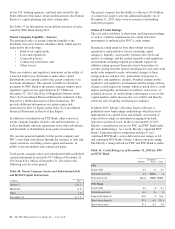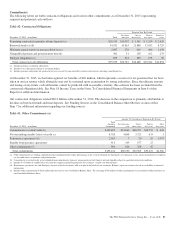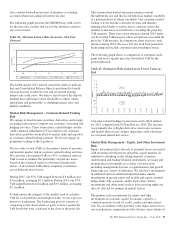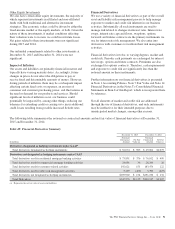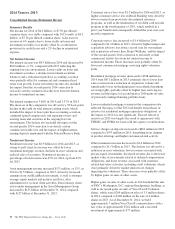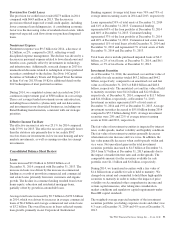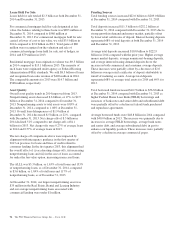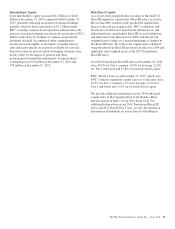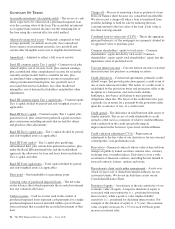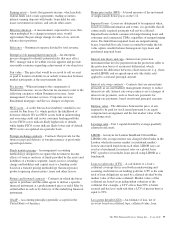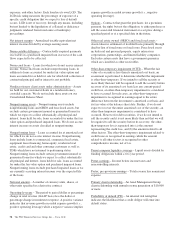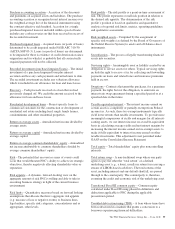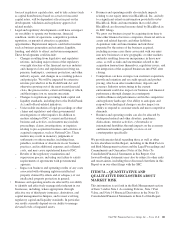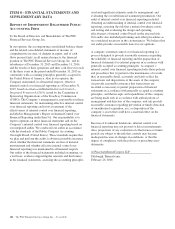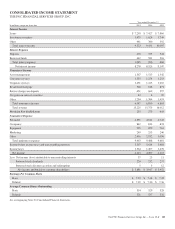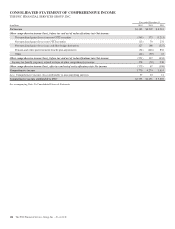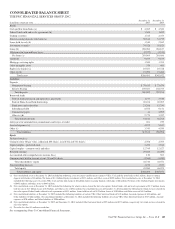PNC Bank 2015 Annual Report Download - page 114
Download and view the complete annual report
Please find page 114 of the 2015 PNC Bank annual report below. You can navigate through the pages in the report by either clicking on the pages listed below, or by using the keyword search tool below to find specific information within the annual report.
G
LOSSARY
O
F
T
ERMS
Accretable net interest (Accretable yield) – The excess of cash
flows expected to be collected on a purchased impaired loan
over the carrying value of the loan. The accretable net interest
is recognized into interest income over the remaining life of
the loan using the constant effective yield method.
Adjusted average total assets – Primarily comprised of total
average quarterly (or annual) assets plus (less) unrealized
losses (gains) on investment securities, less goodwill and
certain other intangible assets (net of eligible deferred taxes).
Annualized – Adjusted to reflect a full year of activity.
Basel III common equity Tier 1 capital – Common stock plus
related surplus, net of treasury stock, plus retained earnings,
plus accumulated other comprehensive income for securities
currently and previously held as available for sale, plus
accumulated other comprehensive income for pension and
other postretirement benefit plans, less goodwill, net of
associated deferred tax liabilities, less other disallowed
intangibles, net of deferred tax liabilities and plus/less other
adjustments.
Basel III common equity Tier 1 capital ratio – Common equity
Tier 1 capital divided by period-end risk-weighted assets (as
applicable).
Basel III Tier 1 capital – Common equity Tier 1 capital, plus
preferred stock, plus certain trust preferred capital securities,
plus certain noncontrolling interests that are held by others
and plus/less other adjustments.
Basel III Tier 1 capital ratio – Tier 1 capital divided by period-
end risk-weighted assets (as applicable).
Basel III Total capital – Tier 1 capital plus qualifying
subordinated debt, plus certain trust preferred securities, plus,
under the Basel III transitional rules and the standardized
approach, the allowance for loan and lease losses included in
Tier 2 capital and other.
Basel III Total capital ratio – Total capital divided by period-
end risk-weighted assets (as applicable).
Basis point – One hundredth of a percentage point.
Carrying value of purchased impaired loans – The net value
on the balance sheet which represents the recorded investment
less any valuation allowance.
Cash recoveries – Cash recoveries used in the context of
purchased impaired loans represent cash payments for a single
purchased impaired loan not included within a pool of loans
from customers that exceeded the recorded investment of that
loan.
Charge-off – Process of removing a loan or portion of a loan
from our balance sheet because it is considered uncollectible.
We also record a charge-off when a loan is transferred from
portfolio holdings to held for sale by reducing the loan
carrying amount to the fair value of the loan, if fair value is
less than carrying amount.
Combined loan-to-value ratio (CLTV) – This is the aggregate
principal balance(s) of the mortgages on a property divided by
its appraised value or purchase price.
Common shareholders’ equity to total assets – Common
shareholders’ equity divided by total assets. Common
shareholders’ equity equals total shareholders’ equity less the
liquidation value of preferred stock.
Core net interest income – Core net interest income is total net
interest income less purchase accounting accretion.
Credit derivatives – Contractual agreements, primarily credit
default swaps, that provide protection against a credit event of
one or more referenced credits. The nature of a credit event is
established by the protection buyer and protection seller at the
inception of a transaction, and such events include
bankruptcy, insolvency and failure to meet payment
obligations when due. The buyer of the credit derivative pays
a periodic fee in return for a payment by the protection seller
upon the occurrence, if any, of a credit event.
Credit spread – The difference in yield between debt issues of
similar maturity. The excess of yield attributable to credit
spread is often used as a measure of relative creditworthiness,
with a reduction in the credit spread reflecting an
improvement in the borrower’s perceived creditworthiness.
Credit valuation adjustment (CVA) – Represents an
adjustment to the fair value of our derivatives for our own and
counterparties’ non-performance risk.
Derivatives – Financial contracts whose value is derived from
changes in publicly traded securities, interest rates, currency
exchange rates or market indices. Derivatives cover a wide
assortment of financial contracts, including but not limited to
forward contracts, futures, options and swaps.
Discretionary client assets under management – Assets over
which we have sole or shared investment authority for our
customers/clients. We do not include these assets on our
Consolidated Balance Sheet.
Duration of equity – An estimate of the rate sensitivity of our
economic value of equity. A negative duration of equity is
associated with asset sensitivity (i.e., positioned for rising
interest rates), while a positive value implies liability
sensitivity (i.e., positioned for declining interest rates). For
example, if the duration of equity is -1.5 years, the economic
value of equity increases by 1.5% for each 100 basis point
increase in interest rates.
96 The PNC Financial Services Group, Inc. – Form 10-K


